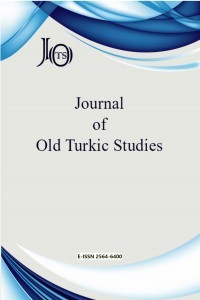Orhon Yazıtları’ndaki Ötükän Yıš İbaresinin Yeni Yorumu
Old Turkic inscriptions, Ötükän Yiš, Old Turkic, Chuvash, Finno-Ugric, Scythians, Huns
Reinterpretation of Ötükän Yıš Expression in Orkhon Inscriptions
Old Turkic inscriptions, Ötükän Yiš, Old Turkic, Chuvash, Finno-Ugric, Scythians, Huns,
___
- Akdoğan, Y. (1999). Azerbaycan Türkçe’sinden Türkiye Türkçe’sine Büyük Sözlük. Beşir Yayınları.
- Aydemir, A. (2010). Ötükän ve Ötükän Adı Üzerine. Türk Dünyası Araştırmaları, 94(187), 197-222.
- Aydın, E. (2007). Ötükän Adı ve Yeri Üzerine Düşünceler. Turkish Studies, 2(4), 1262-1270.
- Aydın, E. (2007). Şine Usu Yazıtı. Karam Yayınları.
- Barat, K. (2007). Some Thoughts on Ötükän. Journal of Old Turkic Studies, 2(2), 7-25.
- Bayram, B. (2002). Çuvaş Türkçesi-Türkiye Türkçesi Sözlük. Tablet Yayınları.
- Bemmann, J. (2011). Was the Center of the Xiongnu Empire in the Orkhon Valley?. In Ursula, B. & Bryan, K. M. (Eds.), Xiongnu Archaeology Multidisciplinary Perspectives of the First Steppe Empire in Inner Asia (pp. 441-461). Rheinische Friedrich-Wilhelms-Universität Bonn.
- Benkő, L. (1993). Etymologisches Wörterbuch des Ungarischen. Akadémiai Kiadó.
- Benzing, J. (1943). Deutsch-tschuwaschisches Wörterverzeichnis nebst kurzem tschuwaschischen Sprachführer. Otto Stollberg.
- Clauson, S. G. (1972). An Etymological Dictionary of Pre-Thirteenth-CenturyTurkish. Oxford University Press.
- Collinder, B. (1977). Fenno-Ugric Vocabulary: An Etymological Dictionary of the Uralic Languages. Hermut Buske Verlag.
- Durand-Guédy, D. (2013). Turko-Mongol Rulers, Cities and City Life. Brill.
- Ergin, M. (2002). Orhun Abideleri. Boğaziçi Yayınları.
- Gabain, A. von (2007). Eski Türkçenin Grameri. Çev. Akalın, M. Türk Dil Kurumu Yayınları.
- Gerey, B. (2005). 5000 Yıllık Sümer-Türkmen Bağları. IQ Kültürsanat Yayıncılık.
- Herodotos. (2004). Herodot Tarihi. Türkiye İş Bankası Yayınları.
- İnan, A. (1998). Makaleler ve İncelemeler. Türk Tarih Kurumu Yayınları.
- Kara, G. (2009). Dictionary of Sonom Gara’s Erdeni-Yin Sang: A Middle Mongol Version of the Tibetan Sa Skya Legs Bshad. Mongol-English-Tibetan. Brill.
- Kaşgarlı Mahmut (1998). Divân-ı Lûgati't-Türk I. Türk Dil Kurumu Yayınları.
- Klyashtorny, S. (1982). The Terkhin Inscription. Acta Orientalia Scientiarum Hungaricae. 36(1), 335-366.
- Klyashtornyj, S. G. (2008). The Terkhin Inscription. In Old Turkic Runic Texts and History of the Eurasian Steppe (pp. 165-196). Editura Academiei Române.
- Korkmaz, E. (2008). Ansiklopedik Eski Türk İnançları ve Şamanizm Terimleri Sözlüğü. Anahtar Kitaplar.
- Ksenefentov, G. V. (2011). Yakut Şamanlığı. Kömen Yayınları.
- Levitskaya, L. S. et al. (1997). Etimologicheskiy Slovar’ Tyurkskikh Yazykov: Obshchetyurkskiye i Mezhtyurkskiye Osnovy na Bukvy “K”, “Қ” (Tom 5). Yazyki Russkoy Kul’tury.
- Malov, S. (1951). Pamyatniki Drevnetyurkskoy Pis'mennosti, Teksty i Issledovaniya. Akademii Nauk SSSR.
- Nadelyayev, V. M. et al. (1969). Drevnetyurkskiy Slovar’. İzdatel’stvo “Nauka” Leningradskoye Otdeleniye Leningrad.
- Naskali, E. G. & Duranlı, M. (1999). Altayca-Türkçe Sözlük. Türk Dil Kurumu Yayınları.
- Onat, A. et al. (2004). Han Hanedanlığı Tarihi: Hsiung-nu (Hun) Monografisi. Türk Tarih Kurumu Yayınları.
- Orkun, H. N. (1994). Eski Türk Yazıtları. Türk Dil Kurumu Yayınları.
- Öztunçer, Ö. (2006). Uygur Şiveleri Sözlüğü (A’dan Z’ye Kadar Transkripsiyonlu Metin). Çanakkale 18 Mart Üniversitesi, Sosyal Bilimler Enstitüsü. (Unpublished Master Thesis).
- Pelliot, P. (1929). Neuf Notes sur des Questions d’Asie Centrale. T’oung Pao, 26, 201-265.
- Radloff, W. (1899). Versuch eines Wörterbuches der Türk-Dialecte II. Tipografiya İmperatorskoy Akademii Nauk.
- Räsänen, M. (1969). Versuch eines etymologischen Wörterbuchs der Türksprachen. Suomalais-Ugrilainen seura.
- Róna-Tas, A. & Berta, Á. (2011). West Old Turkic: Turkic Loanwords in Hungarian I. Harrassowitz Verlag.
- Sebzecioğlu, T. (2015). Ötükän Sözcüğünün Etimolojisi Üzerine Bir Sav: Geçitler ya da Ana Kapı. Sosyal Bilimler Dergisi, 2(2), 44-52.
- Shaw, R. B. (2014). Kâşgar ve Yarkend Ağzı Sözlüğü. Çev. Yıldırım, F. Türk Dil Kurumu Yayınları.
- Ssu-ma Ch’ien, (2011). The Grand Scribe’s Records IX: The Memoirs of Han China/II. Indiana Unniversity Press.
- Starostin, S. et al. (2003). Etymological Dictionary of the Altaic Languages I-III. E. J. Brill.
- Şengül, F. (2020a). The Horse-Related Terms and Animal Names in the Language of the Xiongnus (Asian Huns). The Journal of Eurasian Turkic Studies, 4, 80-104.
- Şengül, F. (2020b). The Language of the Farmer Scythians. The Journal of International Society of Language and Literature, 46, 31-62.
- Tekin, T. (1983). The Tariat (Terkhin) Inscription. Acta Orientalia Academiae Scientiarum Hungaricae, 37(1), 43-68.
- Tekin, T. (2016). Orhon Türkçesi Grameri. Türk Dili Kurumu Yayınları.
- Tuna, O. N. (1997). Sümer ve Türk Dillerinin Tarihi İlgisi ile Türk Dili’nin Yaşı Meselesi. Türk Dil Kurumu Yayınları.
- Türkiye’de Halk Ağzından Derleme Sözlüğü I-XII (1993). II. Baskı. Türk Dil Kurumu Yayınları. (→ DS)
- Uno, H. (2014). Altay Panteonu/Mitler, Ritüeller, İnançlar ve Tanrılar. Doğu Kütüphanesi.
- Uzunkaya, U. (2014). Uygur Sivil Belgelerinden Hareketle Uygurlarda Yerleşik Yaşam ve Bununla İlgili Söz Varlığına Dair. Türkbilig, 27, 41-58.
- Yudahin, K. (1998). Kırgız Sözlüğü I-II. Türk Dil Kurumu Yayınları.
- Zolton, G. (1912). Bulgarisch-Türkischen Lehnwörter in der Ungarischen Sprache. Société Finno-Ougrienne.
- Yayın Aralığı: Yılda 2 Sayı
- Başlangıç: 2017
- Yayıncı: Erdem UÇAR
Orhon Yazıtları’ndaki Ötükän Yıš İbaresinin Yeni Yorumu
Cüveynî’nin Târîh-i Cihân-Güşâ Adlı Yazmasına Eklenen Sözlük
Türk Bengü Taşları Örneğinde Anlam Yapısı Çözümlemesi
Göz Hastalıkları ve Tedavileri Üzerine Eski Uygurca Sūtra’lardan Parçalar
Seçili Anlam Alanındaki Kök Dal Biçimlere Ulaşmada Yeni Bir Yöntem Denemesi
Eine Gelehrte der Seidenstraße. Zum 120. Geburtstag von Annemarie von Gabain am 4. Juli 2021
Der Einleitungsśloka zur „Lehrschrift über das Eintreten in den Abhidharma“ (T. 1554)
